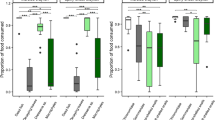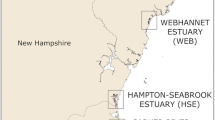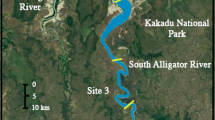Abstract
We review links between autotrophic production, crab herbivory and estuarine food chains in southeastern Australia, a region where mangrove and saltmarsh co-exist towards mangrove poleward limits. Studies in estuaries and embayments across the region have demonstrated a consistent and important role of crab larvae released in synchronised spawning during the spring tide in supplementing the diet of zooplanktivorous fishes. These numerically dominant fishes have been linked through isotopic studies to commercially important predator species. The role of macrophytic vegetation (mangrove and saltmarsh) in the diet of crabs remains controversial, though isotopic analysis has demonstrated the contribution of the C4 grass Sporobolus virginicus to crabs feeding in saltmarsh. Other dietary sources include microphytic algae, and potentially stranded zooplankton. The link between sediment organic matter, crab and zooplanktivore isotopic composition remained tightly coupled in spite of variation in anthropogenic N between estuaries and the isotopic signature of mangroves. Long-term threats to these trophic linkages include coastal squeeze associated with sea-level rise, and the fragmentation and disconnection of habitats.


Data sourced from Mazumder (2004, pp. 99, 100)

Data sourced from Mazumder (2004, p. 110, 111)

Data sourced from Saintilan & Mazumder (2010, p. 618)

After Mazumder et al. (2015, p. 220)
Similar content being viewed by others
References
Aburto-Oropeza, O., E. Ezcurra, G. Danemann, V. Valdez, J. Murray & E. Sala, 2008. Mangroves in the Gulf of California increase fishery yields. Proceedings of the National Academy of Sciences of the United States of America 105(30): 10456–10459.
Alderson, B., D. Mazumder, N. Saintilan, K. Zimmerman & P. Mulry, 2013. Application of isotope mixing models to discriminate dietary sources over small-scale patches in saltmarsh. Marine Ecology Progress Series 487: 113–122.
Armitage, A. R., W. E. Highfield, S. D. Brody & P. Louchouarn, 2015. The contribution of mangrove expansion to salt marsh loss on the Texas Gulf Coast. PLoS ONE 10(5): e0125404.
Bouwmeester, J., A. H. Baird, C. J. Chen, J. R. Guest, K. C. Vicentuan & M. L. Berumen, 2015. Multi-species spawning synchrony within scleractinian coral assemblages in the Red Sea. Coral Reefs 34(1): 65–77.
Bui, T. H. H. & S. Y. Lee, 2014. Does ‘you are what you eat’ apply to mangrove grapsid crabs? PLoS ONE 9(2): e89074.
Cannicci, S., D. Burrows, S. Fratini, T. J. Smith Iii, J. Offenberg & F. Dahdouh-Guebas, 2008. Faunal impact on vegetation structure and ecosystem function in mangrove forests: a review. Aquatic Botany 89(2): 186–200.
Cavanaugh, K. C., J. R. Kellner, A. J. Forde, D. S. Gruner, J. D. Parker, W. Rodriguez & I. C. Feller, 2014. Poleward expansion of mangroves is a threshold response to decreased frequency of extreme cold events. Proceedings of the National Academy of Sciences of the United States of America 111(2): 723–727.
Costanza, R., R. de Groot, P. Sutton, S. van der Ploeg, S. J. Anderson, I. Kubiszewski, S. Farber & R. K. Turner, 2014. Changes in the global value of ecosystem services. Global Environmental Change 26: 152–158.
Epifanio, C. E. & J. H. Cohen, 2016. Behavioral adaptations in larvae of brachyuran crabs: a review. Journal of Experimental Marine Biology and Ecology 482: 85–105.
Giri, C. & J. Long, 2016. Is the geographic range of mangrove forests in the conterminous United States really expanding? Sensors 16(12): 2010.
Gonsalves, L., B. Law, C. Webb & V. Monamy, 2012. Are vegetation interfaces important to foraging insectivorous bats in endangered coastal saltmarsh on the Central Coast of New South Wales? Pacific Conservation Biology 18(4): 282–292.
Guest, M. & R. Connolly, 2005. Fine-scale movement and assimilation of carbon in saltmarsh and mangrove habitat by resident animals. Aquatic Ecology 38(4): 599–609.
Guest, M. A. & R. M. Connolly, 2006. Movement of carbon among estuarine habitats: the influence of saltmarsh patch size. Marine Ecology Progress Series 310: 15–24.
Guest, M. A., R. M. Connolly & N. R. Loneragan, 2004. Carbon movement and assimilation by invertebrates in estuarine habitats at a scale of metres. Marine Ecology Progress Series 278: 27–34.
Harrison, P. L., R. C. Babcock, G. D. Bull, J. K. Oliver, C. C. Wallace & B. L. Willis, 1984. Mass spawning in tropical reef corals. Science 223(4641): 1186–1189.
Herbon, C. M. & I. Nordhaus, 2013. Experimental determination of stable carbon and nitrogen isotope fractionation between mangrove leaves and crabs. Marine Ecology Progress Series 490: 91–105.
Hollingsworth, A. & R. M. Connolly, 2006. Feeding by fish visiting inundated subtropical saltmarsh. Journal of Experimental Marine Biology and Ecology 336(1): 88–98.
Kendall, C., E. M. Elliott & S. D. Wankel, 2007. Tracing anthropogenic inputs of nitrogen to ecosystems, 2nd ed. Blackwell Publishing, London.
Kneib, R. T., 1997. The role of tidal marshes in the ecology of estuarine nekton. Oceanography and Marine Biology 35: 163–220.
Kristensen, E., S. Bouillon, T. Dittmar & C. Marchand, 2008. Organic carbon dynamics in mangrove ecosystems: a review. Aquatic Botany 89(2): 201–219.
Lee, S., 1998. Ecological role of grapsid crabs in mangrove ecosystems: a review. Marine and Freshwater Research 49(4): 335–343.
Loneragan, N. R., S. E. Bunn & D. M. Kellaway, 1997. Are mangroves and seagrasses sources of organic carbon for penaeid prawns in a tropical Australian estuary? A multiple stable-isotope study. Marine Biology 130(2): 289–300.
Lotze, H. K., H. S. Lenihan, B. J. Bourque, R. H. Bradbury, R. G. Cooke, M. C. Kay, S. M. Kidwell, M. X. Kirby, C. H. Peterson & J. B. C. Jackson, 2006. Depletion, degradation, and recovery potential of estuaries and coastal seas. Science 312(5781): 1806–1809.
Lugendo, B. R., I. Nagelkerken, G. Van Der Velde & Y. D. Mgaya, 2006. The importance of mangroves, mud and sand flats, and seagrass beds as feeding areas for juvenile fishes in Chwaka Bay, Zanzibar: gut content and stable isotope analyses. Journal of Fish Biology 69(6): 1639–1661.
Romero-Torresb, M., A. Acosta & E. A. Treml, 2016. The regional structure of spawning phenology and the potential consequences for connectivity of coral assemblages across the Eastern Tropical Pacific. ICES Journal of Marine Science. doi:10.1093/icesjms/fsw218.
Macreadie, P. I., K. Allen, B. P. Kelaher, P. J. Ralph & C. G. Skilbeck, 2012. Paleoreconstruction of estuarine sediments reveal human-induced weakening of coastal carbon sinks. Global Change Biology 18(3): 891–901.
Marcus, S., 2005. Nature and consequences of biological connectivity in mangrove systems. Marine Ecology Progress Series 302: 293–305.
Mazumder, D., 2004. Contribution of saltmarsh to temperate estuarine fish in southeast Australia, Australian Catholic University.
Mazumder, D. & N. Saintilan, 2010. Mangrove leaves are not an important source of dietary carbon and nitrogen for crabs in temperate Australian mangroves. Wetlands 30(2): 375–380.
Mazumder, D., N. Saintilan & R. J. Williams, 2006. Trophic relationships between itinerant fish and crab larvae in a temperate Australian saltmarsh. Marine and Freshwater Research 57(2): 193–199.
Mazumder, D., N. Saintilan & R. J. Williams, 2009. Zooplankton inputs and outputs in the saltmarsh at Towra Point. Australia. Wetlands Ecol Manage 17(3): 225–230.
Mazumder, D., N. Saintilan, R. J. Williams & R. Szymczak, 2011. Trophic importance of a temperate intertidal wetland to resident and itinerant taxa: evidence from multiple stable isotope analyses. Marine and Freshwater Research 62(1): 11–19.
Mazumder, D., N. Saintilan, B. Alderson & S. Hollins, 2015. Inputs of anthropogenic nitrogen influence isotopic composition and trophic structure in SE Australian estuaries. Marine Pollution Bulletin 100(1): 217–223.
McIvor, C. C. & T. J. Smith, 1995. Differences in the crab fauna of mangrove areas at a Southwest Florida and a Northeast Australia location: implications for leaf litter processing. Estuaries 18(4): 591–597.
McKee, K., K. Rogers & N. Saintilan, 2012. Response of salt marsh and mangrove wetlands to changes in atmospheric CO2, climate, and sea level. In Middleton, A. B. (ed), Global Change and the Function and Distribution of Wetlands. Springer, Dordrecht: 63–96.
McPhee, J. J., P. Freewater, W. Gladstone, M. E. Platell & M. J. Schreider, 2015a. Glassfish switch feeding from thalassinid larvae to crab zoeae after tidal inundation of saltmarsh. Marine and Freshwater Research 66(11): 1037–1044.
McPhee, J. J., M. E. Platell & M. J. Schreider, 2015b. Trophic relay and prey switching–A stomach contents and calorimetric investigation of an ambassid fish and their saltmarsh prey. Estuarine, Coastal and Shelf Science 167: 67–74.
Melville, A. & R. Connolly, 2003. Spatial analysis of stable isotope data to determine primary sources of nutrition for fish. Oecologia 136(4): 499–507.
Meynecke, J. O., S. Y. Lee & N. C. Duke, 2008. Linking spatial metrics and fish catch reveals the importance of coastal wetland connectivity to inshore fisheries in Queensland, Australia. Biological Conservation 141(4): 981–996.
Micheli, F., 1993. Feeding ecology of mangrove crabs in North Eastern Australia: mangrove litter consumption by Sesarma messa and Sesarma smithii. Journal of Experimental Marine Biology and Ecology 171(2): 165–186.
Morgan, J. A., D. G. Milchunas, D. R. LeCain, M. West & A. R. Mosier, 2007. Carbon dioxide enrichment alters plant community structure and accelerates shrub growth in the shortgrass steppe. Proceedings of the National Academy of Sciences of the United States of America 104(37): 14724–14729.
Nagelkerken, I., S. J. M. Blaber, S. Bouillon, P. Green, M. Haywood, L. G. Kirton, J. O. Meynecke, J. Pawlik, H. M. Penrose, A. Sasekumar & P. J. Somerfield, 2008. The habitat function of mangroves for terrestrial and marine fauna: a review. Aquatic Botany 89(2): 155–185.
Nobbs, M. & K. A. McGuinness, 1999. Developing methods for quantifying the apparent abundance of fiddler crabs (Ocypodidae: Uca) in mangrove habitats. Australian Journal of Ecology 24(1): 43–49.
Nordlie, F. G., 2003. Fish communities of estuarine salt marshes of eastern North America, and comparisons with temperate estuaries of other continents. Reviews in Fish Biology and Fisheries 13(3): 281–325.
Ólafsson, E., S. Buchmayer & M. W. Skov, 2002. The East African decapod crab Neosarmatium meinerti (de Man) sweeps mangrove floors clean of leaf litter. AMBIO: A Journal of the Human Environment 31(7): 569–573.
Osland, M. J., N. Enwright, R. H. Day & T. W. Doyle, 2013. Winter climate change and coastal wetland foundation species: salt marshes vs. mangrove forests in the southeastern United States. Global Change Biology 19(5): 1482–1494.
Pendleton, L., D. C. Donato, B. C. Murray, S. Crooks, W. A. Jenkins, S. Sifleet, C. Craft, J. W. Fourqurean, J. B. Kauffman, N. Marbà, P. Megonigal, E. Pidgeon, D. Herr, D. Gordon & A. Baldera, 2012. Estimating global “blue carbon” emissions from conversion and degradation of vegetated coastal ecosystems. PLoS ONE 7(9): e43542.
Platell, M. E. & P. Freewater, 2009. Importance of saltmarsh to fish species of a large south-eastern Australian estuary during a spring tide cycle. Marine and Freshwater Research 60(9): 936–941.
Qin, H., Q. Sheng, T. Chu, S. Wang & J. Wu, 2015. Import and export fluxes of macrozooplankton are taxa- and season-dependent at Jiuduansha marsh, Yangtze River estuary. Estuarine, Coastal and Shelf Science 163B: 254–264.
Rabalais, N. N., 2002. Nitrogen in aquatic ecosystems. AMBIO: A Journal of the Human Environment 31(2): 102–112.
Ricardo, G. F., A. R. Davis, N. A. Knott & T. E. Minchinton, 2014. Diel and tidal cycles regulate larval dynamics in salt marshes and mangrove forests. Marine Biology 161(4): 769–784.
Robertson, A. I., 1986. Leaf-burying crabs: their influence on energy flow and export from mixed mangrove forests (Rhizophora spp.) in northeastern Australia. Journal of Experimental Marine Biology and Ecology 102(2–3): 237–248.
Robertson, A. & N. Duke, 1987. Mangroves as nursery sites: comparisons of the abundance and species composition of fish and crustaceans in mangroves and other nearshore habitats in tropical Australia. Marine Biology 96(2): 193–205.
Rogers, K., N. Saintilan, A. J. Howe & J. F. Rodríguez, 2013. Sedimentation, elevation and marsh evolution in a southeastern Australian estuary during changing climatic conditions. Estuarine, Coastal and Shelf Science 133: 172–181.
Rogers, K., N. Saintilan & C. D. Woodroffe, 2014. Surface elevation change and vegetation distribution dynamics in a subtropical coastal wetland: implications for coastal wetland response to climate change. Estuarine, Coastal and Shelf Science 149: 46–56.
Rogers, K., P. I. Boon, S. Branigan, N. C. Duke, C. D. Field, J. A. Fitzsimons, H. Kirkman, J. R. Mackenzie & N. Saintilan, 2016. The state of legislation and policy protecting Australia’s mangrove and salt marsh and their ecosystem services. Marine Policy 72: 139–155.
Saintilan, N., 2004. Relationships between estuarine geomorphology, wetland extent and fish landings in New South Wales estuaries. Estuarine, Coastal and Shelf Science 61(4): 591–601.
Saintilan, N., 2009. Biogeography of Australian saltmarsh plants. Austral Ecology 34(8): 929–937.
Saintilan, N. & D. Mazumder, 2010. Fine-scale variability in the dietary sources of grazing invertebrates in a temperate Australian saltmarsh. Marine and Freshwater Research 61(5): 615–620.
Saintilan, N. & R. J. Williams, 1999. Mangrove transgression into saltmarsh environments in south-east Australia. Global Ecology and Biogeography 8(2): 117–124.
Saintilan, N., K. Hossain & D. Mazumder, 2007. Linkages between seagrass, mangrove and saltmarsh as fish habitat in the Botany Bay estuary. New South Wales. Wetlands Ecol Manage 15(4): 277–286.
Saintilan, N., D. Mazumder & K. Cranney, 2008. Changes to fish assemblages visiting estuarine wetlands following the closure of commercial fishing in Botany Bay. Australia. Aquatic Ecosystem Health & Management 11(4): 441–449.
Saintilan, N., K. Rogers, D. Mazumder & C. Woodroffe, 2013. Allochthonous and autochthonous contributions to carbon accumulation and carbon store in southeastern Australian coastal wetlands. Estuarine, Coastal and Shelf Science 128: 84–92.
Saintilan, N., N. C. Wilson, K. Rogers, A. Rajkaran & K. W. Krauss, 2014. Mangrove expansion and salt marsh decline at mangrove poleward limits. Global change biology 20(1): 147–157.
Sheaves, M., 2009. Consequences of ecological connectivity: the coastal ecosystem mosaic. Marine Ecology Progress Series 391: 107–115.
Sheaves, M., R. Johnston, R. M. Connolly & R. Baker, 2012. Importance of estuarine mangroves to juvenile banana prawns. Estuarine, Coastal and Shelf Science 114: 208–219.
Skov, M. W. & R. G. Hartnoll, 2002. Paradoxical selective feeding on a low-nutrient diet: why do mangrove crabs eat leaves? Oecologia 131(1): 1–7.
Spencer, J., V. Monamy & M. Breitfuss, 2009. Saltmarsh as habitat for birds and other vertebrates. In Saintilan, N. (ed), Australian Saltmarsh Ecology. CSIRO, Melbourne: 149–165.
Acknowledgements
The authors would like to thank Stuart Hankin (ANSTO) for drawing location map of Australia (Fig. 1). Research in SE Australia was conducted with funding assistance from the Australian Research Council and supported by the NSW Office of Environment and Heritage.
Author information
Authors and Affiliations
Corresponding author
Additional information
Guest editors: K. W. Krauss, I. C. Feller, D. A. Friess & R. R. Lewis III / Causes and Consequences of Mangrove Ecosystem Responses to an Ever-Changing Climate
Rights and permissions
About this article
Cite this article
Saintilan, N., Mazumder, D. Mass spawning of crabs: ecological implications in subtropical Australia. Hydrobiologia 803, 239–250 (2017). https://doi.org/10.1007/s10750-017-3150-2
Received:
Revised:
Accepted:
Published:
Issue Date:
DOI: https://doi.org/10.1007/s10750-017-3150-2




